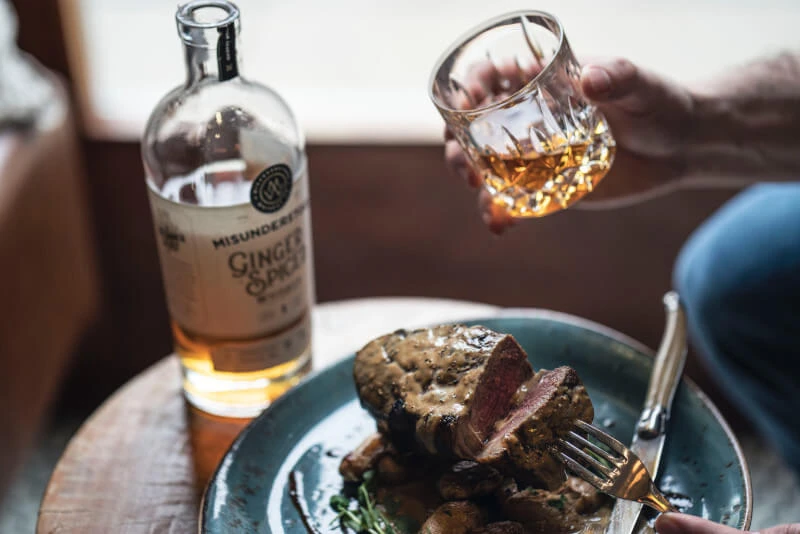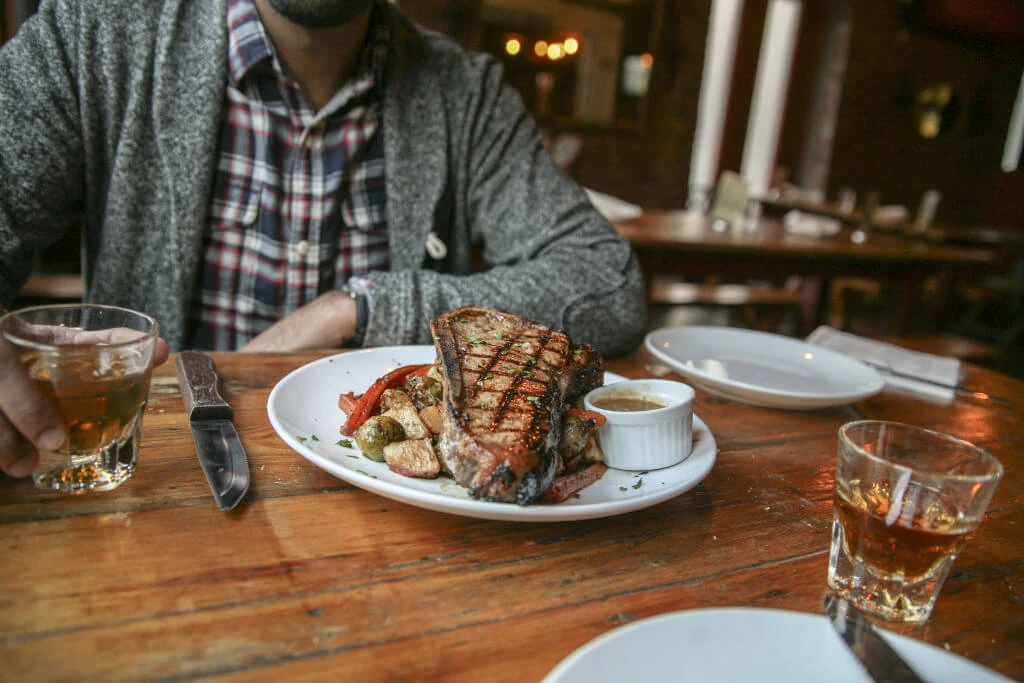You can’t go wrong with steak and just about any beverage. But if you haven’t done this before, here’s a combination that will blow your mind: Steak and a bottle of Scotch. Learn which Scotch is ideal with steak and other meats by reading this article. This is the book for you if you love both Scotch whiskey and meat. We’ll break down why scotch whiskey goes so well with steak and other meats like wild game, and show you how to get the most out of the combination.
Can I have Scotch with my Steak?
The quick response is “yes.” Steak is a great complement to Scotch whiskey. The truth is that there is magic in the way the fat from the steak coats the lips, allowing you to taste every nuance of a whiskey, and the way the whiskey purifies the palate after consuming meat with a richer flavor.
There are a few unknowns to keep in mind, as there are with most whiskey and food combinations. Some scotch whiskies go better with some meats than others. In general, any whiskey will do with any cut of beef. However, the word “almost” in that phrase is important. Whiskey with lower alcohol content and softer flavor profile is recommended when served with bolder meats like wild game. Peated scotch or a high-rye bourbon would pair well with grass-fed grilled tenderloin because of the added spice.
Steak and Scotch: A Perfect Match

The best Scotch whiskey to serve with your steak depends largely on the cut of meat you’ve chosen. Just as different types of scotch whiskey and preparation methods affect the overall flavor, so too do different cuts of beef. A few guidelines for creating the perfect whiskey and food pairing have been discussed in previous articles:
- When combined with bitterness, sweet and salty flavors find harmony.
- Salty flavors benefit from sourness since it counteracts the sweetness or heat.
- All flavors benefit from a dash of salt.
- The sweetness balances off the heat, smoke, and salt in the dish, as well as the sting of the alcohol.
- Fruity undertones are heightened by sweet tastes.
- The heat complements the other spiciness and brings out the sweetness in other flavors.
- Smokey flavors complement existing smokey flavors and bring out caramel undertones.
- smells that are bright and new (like mint or herbs) pair well with flowery and herbal notes, and complement sugary smells.
- Nuttier flavor will complement the woodsy ones, highlighting the sweetness and heat.
Picking a Meat Cut
Before deciding on a Scotch whiskey and meat combo, you should probably decide whatever cut of meat you’ll be cooking. The meat’s flavor is affected by many factors, including the cut’s fat content and the diet the animal was given. What the animal consumes throughout its lifetime is the single most essential aspect. Beef that has been fed grains or maize will be more fatty and have a sweeter flavor. In turn, grass-fed beef will taste fresh and raw, with notes of herbal flavor.
Another thing to think about is the beef’s actual cut. It’s what decides if the beef has bone and the potential to dry-age, as well as whether it has a high or low level of marbling. The marbling (the little cubes of fat) in a piece of meat will impact how well it takes on seasoning while cooking. The juicier the steak, the greater the flavor it is going to absorb from the seasonings you use when cooking.
The meat typically has a nuttier flavor due to the presence of the bone in the cut. T-bones and other bone-in cuts have a more robust, robust flavor. In turn, dry-aging the beef enhances the meat’s inherent taste. This technique involves removing the meat from the refrigerator and letting it rest for weeks (or even months) in a controlled setting, where it will not spoil. The meat becomes more delicate as it ages in a dry environment. And similar to whiskey, the more it is aged, the more robust the flavor becomes.
Finally, decide how you’ll cook the meat and what seasonings you’ll use. Both the meal and the scotch you select to drink with it will be affected by these factors. The greatest scotch for steak depends on the type of meat you’re having.
Scotch Whiskey Selections
After deciding on the cut of meat for dinner, the next step is to select the perfect scotch to accompany it. Similar to many other whiskey combinations, you can either go for harmony, or you can experiment with contrasting flavors. To find the best pairing, think about how the flavors interact with one another. Scotch, with its many varied flavors and personalities, could be the ideal whiskey to pair with various cuts of beef.
Steaks fed on grass, for example, could benefit from being served with a more refined scotch. In contrast, a peated scotch will complement a grain-fed steak more robustly without masking its flavor. Depending on the amount of marbling in the beef, a fuller-bodied whiskey (such as one aged in an ex-sherry cask) would go well with fatty cuts. Just turn the possibilities around if you want to play with opposites.
When preparing a steak with bone, a single-grain scotch whiskey is a good choice because its subtle flavors complement the meat’s natural nuttiness. Pick the seasonings you’ll use in the kitchen, and experiment with combining different flavors. You may try a Speyside Scotch whiskey with your next herb-based meal. A deep-peated flavor is ideal for grilling.
The Ideal Scotch for a Meaty Meal

Now that you know which scotch goes best with steak or other beef dishes, we’ll introduce you to some dynamic duos.
Highland Park’s 18-year Barrel and Grass-fed Tenderloin
The Viking Pride is a Single Malt Scotch whiskey aged 18 years. One of the miracles of the Highland Park brand, this expression keeps winning awards year after year. Peated scotch whiskey with hints of dark chocolate, peat, and honey from its time in sherry and American oak casks. The Tenderloin Steak is the perfect complement to this rare and pricey whiskey.
The citrus, sea salt, and aromatic peat smoke in the Highland Park 18-Year-Old Scotch will complement the fresh, herbaceous flavor of the grass-fed beef in this delicate steak.
Grain-Fed Steak with Monkey-Shoulder Blended Scotch
It’s not true that Monkey Shoulder can only be used in alcoholic beverages. If you’re looking for the ultimate complement to a grilled steak, go no further than this blended Scotch whiskey.
Although originally intended for blending, Monkey Shoulder is a smooth, rich, and award-winning Scotch whiskey that may be enjoyed neat. The Balvenie, Kininvie, and Glenfiddich whiskey were used to create this mix, so you can anticipate a smooth, fruity drink.
Monkey Shoulder’s roasted barley and spicy tastes will complement the smokiness of a grilled steak. The nutty aromas of the grain-fed steak will complement the fruity flavors of the whiskey, which include berries.
Steak’s sugarier undertones might be complemented with other sweet flavors like vanilla, honey, or butterscotch. This meat typically has a higher fat content than grass-fed alternatives. This is because the fat will dull the whiskey’s harshness, enhancing your ability to pick out individual notes. Among the finest scotches for sipping with a steak is a bottle of Monkey Shoulder. When it comes to blended scotch whiskey, monkey shoulder may be your best bet.
Aberlour Casg: Combination of Dry-aged Rib Eye With Single Malt Scotch
Possibly the greatest steak-friendly scotch is this Aberlour expression. The Casg Annamh, which is aged in Spanish Oloroso Sherry casks, is a luxuriously sweet dram that calls for an exceptional steak.
Aberlour is a great example of the delicious and smooth whiskey that Speyside is famous for producing. Cinnamon, clove, ginger, and nutmeg give this a mildly spicy flavor. A dry-aged steak has a nutty flavor and is extremely tender. Aberlour Casg Annamh Single Malt Scotch whiskey is ideal for this dish since it complements the rich flavor of the steak.
Grilled Grass-Fed Steak with Auchentoshan Three Wood Single Malt Scotch whiskey
One of the glories of the Scottish Lowlands, Auchentoshan Single Malt whiskey has been producing top-tier spirits ever since it first opened its doors. As its name suggests, The Three Woods was aged in three different kinds of wood.
Auchentoshan Three Wood Single Malt whiskey begins its maturation in ex-Bourbon barrels before moving on to Oloroso Sherry barrels and finally finishing its time in Pedro Ximenez Sherry Casks. This method of aging produces a dram that is rich in flavor and aroma, with notes of fruit and sweetness. This scotch, thanks to its lengthy aging procedure, is excellent with steak. Raw grass-fed beef complements the sweet sherry and caramel aromas in this Auchentoshan expression, while grill marks bring out the nutty and peppery undertones. This dram has a clean, crisp finish that brings all the tastes together well.

